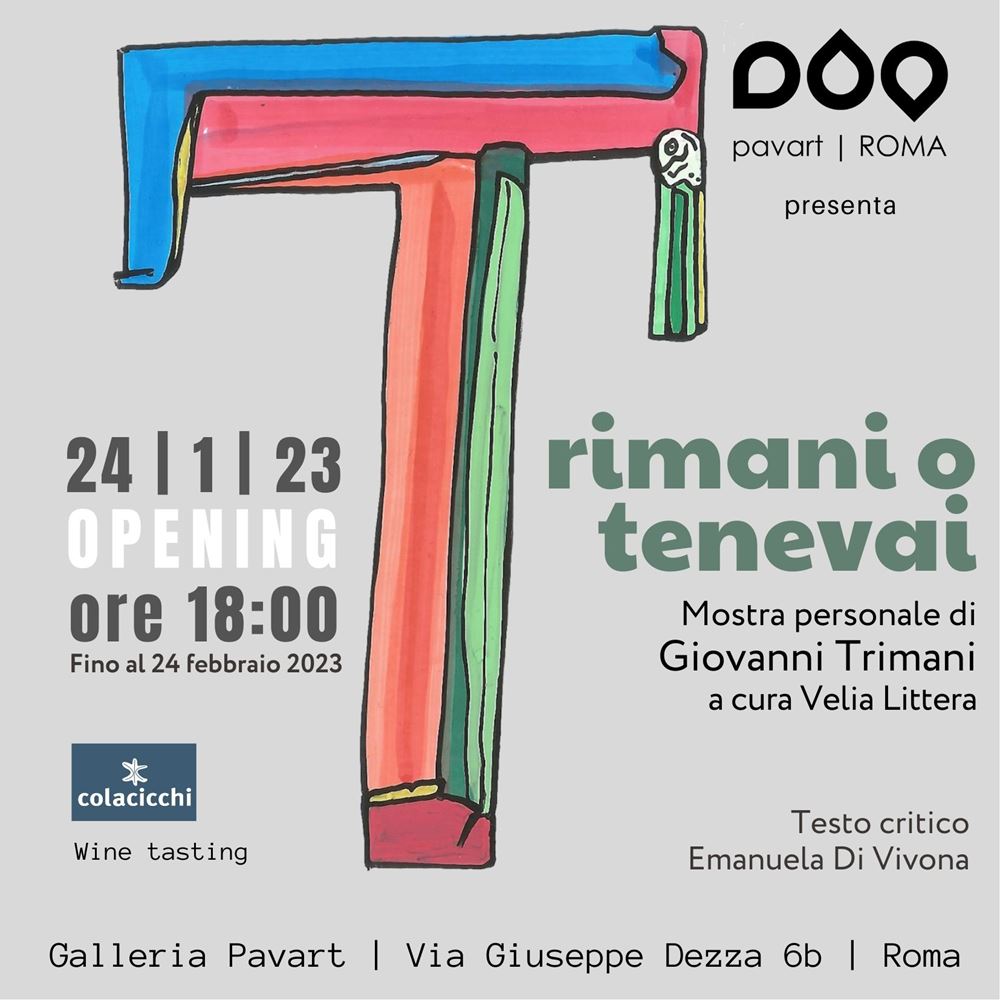


“Trimani o Tenevai” will be the first stop of a journey through the artistic evolution of
Giovanni Trimani, a journey to discover his many facets.
Giovanni Trimani’s works filter the influences of past masters, modulated in a totally
personal and contemporary key. Among the various works by Trimani we can find Picasso, Maccari, Manzù, the fauve colors and the emotional strength of German expressionism.
Giovanni Trimani is an artist who starts from the experiences of his life, elaborating them and proposing his emotions in a key that is as universal as possible, so that it can be
shared by anyone. And here is the strength of an artist: being able to reach the heart of the user, being able to narrate the user’s emotions through its own.
Officially his professional career began in 2007, but actually, his artist soul began to
emerge twenty years earlier.
In this exhibition we will have the opportunity to admire some works from the 1990s which are totally destabilizing however conceal the path that he will carry out in future years.
The two works are Amica and Ballo, both from 1999, two acrylics on wood that arise anxieties, reflections, strong and contrasting emotions, heritage of the rawness and
immediacy of German expressionism that lead us back to the more intimate and less phenomenal character of the avant-garde of the early twentieth century.
The “death” seen as a dear friend, and an almost ancestral and primitive “dance” that awakens and destabilizes the depths of human interiority.
Ever since his first works, Giovanni Trimani has placed sign and colors at the center of his artistic research, elements that derive from a dispassionate love for expressionist art, but also by the appeal of stained glass art.
This deep bond with Gothic stained glasses has personal roots. In fact, ever since he was a child, when he went to the family tomb at the Verano cemetery, he watched in
enchantment a stained glass window that lit up thanks to sunlight. And that otherwordly vision accompanied him in his artistic career.
Like the stained glass windows, also Giovanni Trimani’s artworks recall the mosaics of small pieces of pure color, connected not by lead bindings, but by a black mark that has the task of highlighting the modeling, as it happened in the Middle Ages.
The acid and strident color that we had caught in nuce, in his early works, we rediscover it in all the following art production: from the Giullari, to the Nomadi, up to the works
belonging to the Assedia project.
This last project was born from a series of lucky coincidences perhaps considered as fate. Two people reflecting on the same subject at the same time. Giovanni Trimani writes a new poem in 2016; Francesca Bogliolo, Italian art historian, rereads a poem written by the artist the year before. Both decide to organize a personal exhibition on the theme of the chair in February 2017 and so it was.
The chair is the subject he most represented in recent years. The chair conceived not as a still life, but as a series of portraits that describes the human universe. In fact, each chair is different from the other, through colors or shapes. Each chair tells a story.
In the series Sedia in stanza from 2016, the link with the Cubist decomposition of Picasso or Braque is clear, in which any perspective relationship is canceled and the elements are inserted into an oniric space.
The colors and the sign continue to be the absolute protagonists of Trimani’s artworks: pure and bright colors in contrast with the black sign of contour that takes us back there, to the color of expressionism and to the magiclight of Medieval stained glass windows.
The oniric dimension and the cubist decomposition of reality can also be found in the Giullari and the Nomadi art series in which there is a strong reference to the memory of Jean Dubuffet’s Art Brut, but above all, the memory of the faces of Mino Maccari, his
violent and graphic drawing and quick brush strokes.
Giovanni Trimani has experimented with all painting techniques, from oil to watercolor, from pastel to tempera, then focusing on acrylic. In sculpture, on the other hand, he
dedicated himself to the processing of iron.
In the exhibition “Trimani o Tenevai” there will also be a sculptural work Matite created in 2016, in which all the elements that come to life through the pictorial material on his
canvases are transposed into sculpture: the two-dimensional chair acquire a
three-dimensionality in becoming iron, as do the acrylic colors that he uses in his
paintings acquire a body, becoming pencils. This work becomes a metaphor for the
precarious balance of human existence: a life poised between pointed spears.
All Giovanni Trimani’s art works are autobiographical, but not self-referential. In fact, the artist wants to speak to the viewer, create works in which the viewer can enter, where he can recognize himself. An art work, up to Giovanni, lights up, acquires meaning, only when it has an audience.
Giovanni Trimani creates art not only for himself, but for anyone willing to enter his world. (Emanuela Di Vivona)
|
This website uses third party cookies | X |
 This site uses anonymous technical cookies to ensure navigation and third-party cookies to monitor traffic and to offer additional services such as viewing videos or messaging systems. Without third-party cookies some pages may not work properly. Third-party cookies can track your activity and will only be installed by clicking on the "Accept all cookies" button. You can change your selection at any time by clicking on the "Cookie" link on each page at the bottom left. By clicking on one of the two buttons you declare that you have read the privacy policy and to accept the conditions.
This site uses anonymous technical cookies to ensure navigation and third-party cookies to monitor traffic and to offer additional services such as viewing videos or messaging systems. Without third-party cookies some pages may not work properly. Third-party cookies can track your activity and will only be installed by clicking on the "Accept all cookies" button. You can change your selection at any time by clicking on the "Cookie" link on each page at the bottom left. By clicking on one of the two buttons you declare that you have read the privacy policy and to accept the conditions.
| |
|